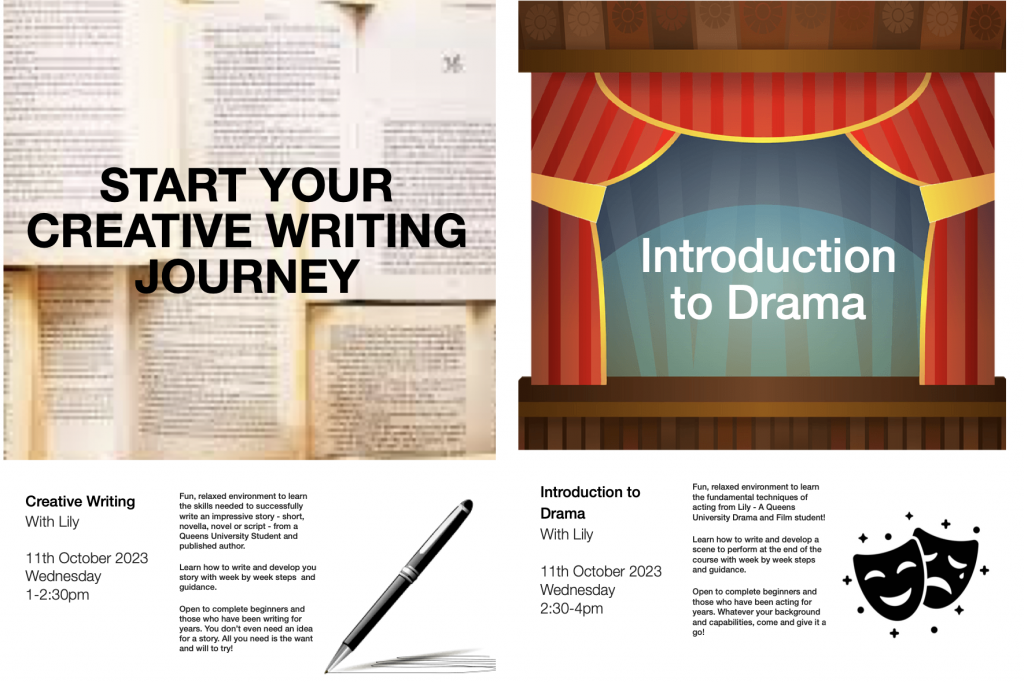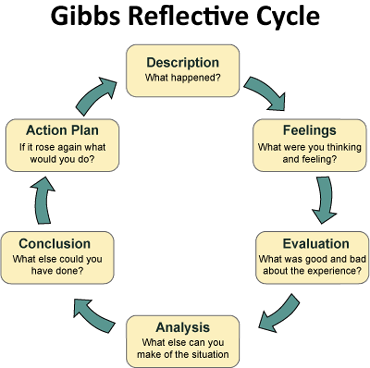My placement occurs on a Wednesday afternoon in action mental health, Belfast (AMH). My role responsibility is that of skills coach where I devise and deliver my own unaccredited courses to vulnerable adults who are moderately to severely mentally ill and special educational needs, to aid in their recovery, promote personal wellbeing and develop resilience. The aim of unaccredited courses are for the clients to learn about a subject that interests them but through the teaching there should be an encouragement to develop their personal wellbeing and self-confidence. I decided, for my first semester to devise a creative writing 10-week course and an introduction to drama 10-week course.

I have an interest in teaching but currently unsure of what age range I want to focus on before deciding on my PGCE. Prior to summer, I volunteered for a few days in both primary and secondary schools developing knowledge and skills about devising lesson plans and teaching classes. I felt rather confident and capable going into placement having already had experience and knowledge of devising lessons and leading classes.
I spent the first two weeks of my placement devising my courses and meeting the new clients joining the organisation. On my third week, I began my first class for creative writing, and this is the experience I choose to reflect upon.
I have chosen to systematically reflect upon my experience using Gibb’s reflective cycle. My decision for using this model over many others is due to its six stages which guide the user through the reflective process ensuring a thorough reflection and encouragement to be critical of the experience.[1]
[1] Jasper, M. (2013) Beginning reflective practice. 2nd ed. Melbourne;: Cengage Learning. Pp. 80-82

Description
Before the class started, I was shown to my classroom and checked I had all my necessary equipment – booklets I had created, attendance sheet and a mug filled with pens for the clients to use. I was warned in advance that attendance may not be strong and some people who are not recorded on the attendance sheet may turn up if they feel like attending the class. This is a common occurrence in AMH as some clients who may be having a good day with their mental health may want to try out other classes once they’re in the building while some other clients may be too ill to attend class. This is completely allowed and must be accommodated for in all classes.
Before long the class had begun – two people on the attendance sheet and two people who decided to turn up. I asked each for their names and pronouns (as is standard protocol), handed out booklets and began the lesson.
I discussed different strategies to finding inspiration for ideas for a story and we practiced a few as a class before giving them five minutes for each strategy to try it themselves. I offered them a chance to read out each of their ideas before moving on to the next strategy. I had remembered after 50 minutes that I am meant to give the class a break in the middle so I opted for ten minutes to let them get tea and biscuits. I chatted away asking them what they’re doing later in the day and trying to build a rapport with each client. After ten minutes, we came back to work to finish strategies and move onto discussing different types of genre and audience expectation. We finished the class with the aim to practice strategies at home and return next week with an idea for a story to further develop further.
After class, I discussed with another skill coach who was supervising my class about what I did well and what I need to improve upon. I was told they were impressed at how much co-operation the clients were giving and their excellent participation in class. The content of the lesson itself was very sophisticated and interesting. However, the break should have come sooner in the class and to give them a little longer. My teaching should have been at a slower pace. I must remember the clients are only beginning their recovery from severe mental illness and have been out of education and work for some time so while I feel the content is simple, it may be challenging for them to understand. I also need to aim at getting the clients to interact more with one another and not just me so they build friendships and better social skills.
Feelings
Throughout the class I felt calm but recognised the quietness of the room. I tried to engage in conversation, but it felt awkward and forced at times. I felt I was going at a too slow a pace for such simple content but understand now I should have slowed it down further. I did feel a little gutted and stupid during my discussion with the skills coach that I didn’t think of the simple matter of how the clients were handling their first class with me. However, I was reassured by the skills coach that many new skill coaches (particularly those who have come from teaching in school settings) also struggle with the pacing of classes at AMH.
Evaluation
I provided a relaxed, welcoming environment where all the clients felt safe to share their personal creative ideas throughout the entire 90-minute class. This is a key factor in leading these classes as “we remember much of our experiences of participation in embodied form. This means the experience of participation are remembered in our muscles, senses and actions…”[2]. Therefore, the clients remembered being listened to and heard without judgement each time they contributed to the class and felt they could continue contributing throughout.
However, there are areas for improvement. According to the supervising member of staff I need to ensure I go at a slower pace when explaining the content and give the clients a little longer to complete the exercises I set for them. If I rush through everything too quickly, the class will become too challenging for them, and they may opt to attend a different class instead or just simply not turn up. I must try to get the clients interacting with one another and not just me, so they form strong social ties and feel apart of the AMH community.
Analysis
Upon reflection, I believe the reason why I went through the content so quickly is because when I have previously taught classes in schools, I was given a lot of content to explain to a large number of children within a short space of time. I applied a similar principle to this class unnecessarily.
While I asked questions to the clients about their names, pronouns and experience with creative writing at the start of the class, I did not expand further as I did not want to pry or make them feel uncomfortable. However, in doing so the clients knew very little about each other and it made it difficult for them to begin a conversation with one another.
Conclusion
To aid in the clients’ social integration within the class, I could have set group work or pair work so they could complete an exercise together. This would have encouraged them to talk to one another at least about the exercise at hand and break down the initial difficult hurdle of introducing yourself to someone and the awkward small talk where neither party knows what to talk about.
Action Plan
I must remind myself that I am not simply teaching the basics of creative writing to a group of people but that I am aiding them on their recovery journey through the medium of a subject they are interested in. I am coaching them in rehabilitating their soft social skills and personal development. Therefore, in future classes I will give the clients a longer period of time to think while doing their independent work and remember they need a break sooner and for longer so they can relax and take time to themselves or to converse with others in the class before coming back in to do more work.
In future, when I begin a new course at AMH I will begin by adapting an icebreaking exercise I found in Walker’s book, Teaching creative writing practical approaches (2012): I will ask each person to say and explain what their favourite book/film/play is and is it similar to the type of writing they enjoy partaking in. This encourages the shier people in the class to become involved and sets “boundaries for those who would otherwise tell their life story.”[3] While also providing an opportunity for people with similar taste and interest to bond.
“The cycle is completed tentatively by suggesting that the next time the event occurs it will be the focus of another reflective cycle.”
Jasper, M. (2013)
[1] Walker, E. (2012) Teaching creative writing practical approaches. ELY [England: professional and higher partnerships ltd]. Pp. 15
[1] Kelly, P. (2011) Unconsidered activity, craft expertise and reflective practice in teaching. Reflective practice [online] 12(4) 557-568.
References
Jasper, M. (2013) Beginning reflective practice. 2nd ed. Melbourne;: Cengage Learning. Pp.80-82
Kelly, P. (2011) Unconsidered activity, craft expertise and reflective practice in teaching. Reflective practice [online] 12(4) 557-568.
Walker, E. (2012) Teaching creative writing practical approaches. ELY [England: professional and higher partnerships ltd]. Pp. 15